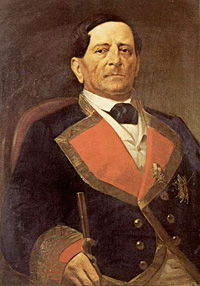Northern Mexico Border Set Dec. 30, 1853
 Andrew Glass - Politico Andrew Glass - Politico
go to original


| | Gen. Antonio Lopez de Santa Anna |
On this day in 1854, James Gadsden (1788-1858), the U.S. minister to Mexico, and Gen. Antonio Lopez de Santa Anna, the president of Mexico, signed an accord turning over some 30,000 square miles of what is now part of southern New Mexico and Arizona to the United States.

The Americans, sensing an opportunity to build a railroad through the region, drove a hard bargain.

The deal soon revolted Mexican sensibilities and led to Santa Anna’s downfall.

Gadsden, the grandson of American Revolutionary patriot Christopher Gadsden, received his bachelor's degree from Yale in 1806. In 1823, after a career as a U.S. Army officer, he was commissioned to help the federal government move Seminoles westward to reservations.

While president of the South Carolina Railroad Co. from 1840 to 1850, he advocated construction of a transcontinental railroad via a southern route.

The treaty with Mexico, known as the Gadsden Purchase, was signed in Mexico City.

It settled a long-standing dispute over the demarcation of the border west of El Paso, Texas.

The deal called for the United States to pay Mexico $15 million, or about $150 million in today’s dollars, although the price was later cut to $10 million.

The Mexican economy was going through a rough patch.

The Mexicans desperately needed the money, leaving Santa Anna in a weak negotiating position.

Jefferson Davis, the secretary of war under President Franklin Pierce, authorized Gadsden to parley with Santa Anna for the land, which was deemed by U.S. political and industrial leaders to be the best southern route for a transcontinental railroad.

In 1861, capitalizing on the purchase, the chief figures behind the drive to build railroads through the West — Collis Huntington, Leland Stanford, Mark Hopkins and Charles Crocker — formed the Southern Pacific branch of the Central Pacific Railroad |



